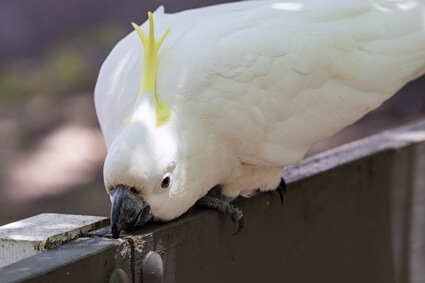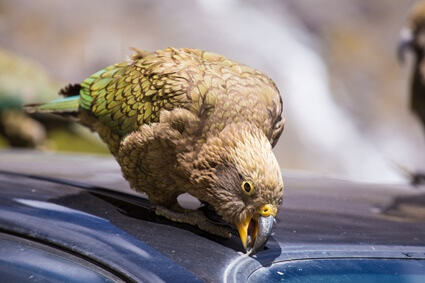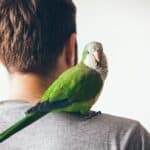Last Updated on January 28, 2024 by Carrie Stephens
Parrots bite, dismantle items, and chew furniture, leaving a trail of destruction in their wake. Instincts, playfulness, boredom, stress, jealousy, and attention-seeking all lead to destructive behaviors.
Ways parrots destroy the home include:
- Chewing household furniture.
- Unraveling fabric (clothes, pillows, curtains.)
- Shredding paper (books and paperwork).
- Dropping and throwing food.
- Pooping everywhere, inside and outside the cage.
- Destroying and ripping apart toys.
- Breaking or dropping their eggs.
Problems also arise due to a lack of behavioral training, defined boundaries, and in-cage enrichment.
Why Parrots Are So Destructive
Parrots have wild instincts, using their strong beaks to break open objects (like nuts and seeds). Chewing and biting also wear down the beak, reducing the risk of overgrowth and misalignment.
A pet parrot is fed regularly, so it doesn’t need to forage for food. Its wild instincts are retained, so a parrot will drop food everywhere and wear down its beak on household items.
You may be able to train a parrot out of these habits by providing a well-optimized living environment. This includes out-of-cage exercise, toys, one-on-one attention, and behavioral training.
Here are some common causes of destructive behavior in parrots:
Boredom
Animal Welfare explains how insufficient freedom and stimulating activity leads to problem behaviors.
Parrots cope poorly with boredom. If a parrot is kept in a cage all day and night without mental stimulation or company (human or avian), it’ll seek destructive outlets.
If you leave a parrot alone, ensure it has things to occupy itself. This can be achieved by providing perches at different levels, nutritious food, rope ladders, bells, puzzles, and chew toys.
Some owners provide mirrors, which causes lone parrots to think they have a companion. Unfortunately, putting a mirror in the cage can confuse parrots (like budgies), leading to behavioral problems.
If a parrot acts aggressively toward its mirror, add one with distorted glass or remove it entirely.

Stress and Anxiety
As fun-loving and playful as parrots are at times, they’re easily stressed and startled. If a parrot works itself into a state of heightened emotion, especially fear, it’ll act out.
Animals stated parrots with chronic stress may self-mutilate, such as feather-destructive behavior (FDB). Once released, a parrot will turn these behaviors on furniture and household items, causing damage.
Attention-Seeking
Parrots develop a deep affection for their owners. If a parrot feels ignored, it may resort to bad behavior, leading to admonishment. In a parrot’s mind, negative attention is better than no attention.
Learn the meaning behind body language cues and verbalizations, understanding when a parrot wants to be petted, played with, or talked to.
Parrots that lack a mate may develop an inappropriate attraction to their human carers. They’ll display behaviors like jealousy, vent rubbing, aggression, and regurgitation.
How To Stop A Parrot from Destroying Things
Keep anything vulnerable or valuable out of reach until training has been completed. Once the home has been parrot-proofed, commence an ongoing training process.
Training
Training a parrot takes time and requires a calm and patient approach. Just as a child won’t develop a complete set of life skills in one session, the same applies to parrots.
If a parrot is acting destructively, don’t yell because you could frighten it or exacerbate an anxiety problem. This could lead to the manifestation of other unwanted behaviors.
Also, parrots sometimes associate their destructive behavior with getting the attention that they crave from you. Far from being deterred, it’ll misbehave more frequently.
A destructive parrot should be distracted from household items with recreational activities. Praise and reward the parrot when it ceases to behave undesirably.
Dietary Review
Wild parrots are used to opening shelled foods with their strong beaks.
If a parrot’s diet comprises excessive soft foods like fruits and vegetables, it may lack the opportunity to keep its beak trim and aligned. This can lead to an overgrown, misaligned beak.
Manual break trimming won’t be essential if you provide resilient and abrasive foods (and objects).

Fun Toys
Wooden blocks enable parrots to peck at and wear down their beaks. Children’s blocks (old baby toys) may be okay, but ensure they’re undamaged, blunt, and unpainted to prevent harm.
You can give a parrot a wicker basket to peck at and unravel. This will be even better if you fill it with crumpled paper. A toilet roll will also keep a parrot occupied.
An unwanted telephone directory is another way to encourage a parrot to destroy things safely. Perhaps you’ve got some cardboard for a parrot to tear up with its beak.
Companion Parrot
A parrot with a same-species friend is less likely to act out. It’ll have a companion with which to interact and engage. An opposite-sex parrot is preferred, but some same-species pairings work.
Not all parrots get along well. Careful introductions and monitoring are essential to ensure everyone remains safe and happy. Two parrots will need a bigger living space and more resources.
Also, new parrots must be quarantined for 30 to 45 days to avoid passing on illness and disease.
Establish a Routine
Create a stimulating environment and establish a routine that includes time outside the cage with you.
Ensure the cage is large enough to permit movement and extension of the wings. Also, add mentally stimulating toys and food puzzles. Exercise promotes superior mental well-being.
Companion Animal recommends foraging, play, and visual and aural entertainment. Regularly check on and engage with the parrot because they need human interaction.
Parrots don’t understand human language but enjoy mimicry and engagement.
Parrots retain their wild instincts, even if born and raised in captivity. This means you must meet them halfway. Destructive tendencies can be curtailed with ongoing training, fun, and engagement.





